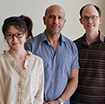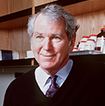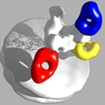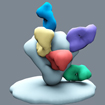Research Advances from 2014
In 2014, scientists at The Scripps Research Institute (TSRI) continued to make strides in their quest to understand the fundamental processes of life and advance human health. Here is a small sampling of the many advances from TSRI in the last year.
Drug for Multiple Sclerosis and Ulcerative Colitis Advances |
 |
Positive new data were released in two separate clinical trials of a drug candidate first discovered and synthesized at TSRI, advancing potential new treatments for both multiple sclerosis and ulcerative colitis.
RPC1063 was first discovered by a “hit” from an NIH molecular library at Scripps Florida’s Molecular Screening Center. It was then synthesized and further developed in the laboratories of Scripps California Professors Ed Roberts and Hugh Rosen.
San Diego biotechnology company Receptos, Inc. has licensed the compound. After Phase 2 results suggesting the drug is safe and effective, the company is now conducting late-stage clinical trials with patients suffering from the two autoimmune conditions.
“We are delighted that RPC1063 is showing promise,” said Rosen. “The unique multidisciplinary environment in chemistry and biology at TSRI allowed this progression to clinical trials.”
Mimic of 'Good' Cholesterol Could Fight Heart Disease and Stroke |
 |
Scientists created a synthetic molecule that mimics “good” cholesterol and showed it can reduce plaque buildup in the arteries of animal models. The molecule, taken orally, improved cholesterol in just two weeks.
This research, funded by the National Institutes of Health (NIH) and the American Heart Association Western States Affiliate, points scientists toward a new method for treating atherosclerosis, a condition where plaque buildup in the arteries can cause heart attacks and strokes.
“Atherosclerosis is the number-one killer in the developed world,” said TSRI Professor M. Reza Ghadiri, senior author of the new study with TSRI Assistant Professor of Chemistry Luke Leman. “This research clears a big step toward clinical implementation of new therapies.”
Chemical Biologists Tackle ‘Undruggable’ Target to Block Tumor Growth |
 |
TSRI chemical biologists invented a new method to disrupt the function of MYC, a regulator involved in a majority of cancers that had been thought to be “undruggable.”
The researchers found that a molecule they developed moves in and disrupts the critical interactions between MYC and it's binding partner MAX. They also showed the drug candidate can stop tumor growth in animal models.
“We finally hit a home run with this—maybe a grand slam,” said Kim Janda, co-author of the new study and Ely R. Callaway, Jr. Professor of Chemistry, director of the Worm Institute for Research and Medicine, and Skaggs Scholar and member of the Skaggs Institute for Chemical Biology at TSRI.
In other work this year, the Janda laboratory corrected one of the most talked about errors in the drug industry, an inaccurate structure of a drug known as TIC10 that had reached Phase 1 clinical trials. The highly promising anticancer compound—now with the amended structure—is in clinical trials for cancer patients.
Surprise Findings Suggest Anti-Alzheimer’s Approach |
 |
In surprising findings, transthyretin, a protein with a propensity to form harmful aggregates (clumps) in the body when produced in the liver may protect against Alzheimer’s disease aggregates when produced in the brain. Nerve cells appear to make more of the molecule to protect themselves against the harmful effects of the Alzheimer’s protein.
The new study suggests that drugs that can boost the production specifically in the neurons of older people (whose brains’ manufacture of transthyretin decreases with age) could one day help ward off Alzheimer’s disease. “This result was completely unexpected when we started this research,” said TSRI Professor Joel N. Buxbaum. “But now we realize that it could indicate a new approach for Alzheimer’s prevention and therapy.”
In other work that offers fresh insights into the disease, a team led by Srinivasa Subramaniam, funded by an O’Keeffe Neuroscience Scholar Award and the State of Florida, identified new elements of a pathway deeply involved in the Alzheimer’s progression. Another study led by Professor William E. Balch suggested “protein misfolding” diseases such as Alzheimer’s and cystic fibrosis can be seriously exacerbated by the body’s response to that misfolding, providing fundamental insights that will immediately affect design of new therapies.
Revealed: Weak Spots in Ebola’s Defenses |
 |
A team identified weak spots on the surface of Ebola virus that are targeted by the antibodies in ZMapp, the experimental drug cocktail administered to several patients during the recent Ebola outbreak. The study, led by TSRI structural biologists Andrew Ward and Erica Ollmann Saphire, provides a revealing 3-D picture of how the ZMapp antibodies bind to Ebola virus.
“The structural images of Ebola virus are like enemy reconnaissance,” said Saphire. “They tell us exactly where to target antibodies or drugs.”
Ward added, “Now that we know how ZMapp targets Ebola, we can compare all newly discovered anti-Ebola antibodies as we try to formulate an even better immunotherapeutic cocktail.”
New Strategy Takes Aim at ALS, Frontotemporal Dementia |
 |
A team led by researchers from Scripps Florida and the Mayo Clinic successfully designed a therapeutic strategy targeting a specific genetic mutation causing a common form of amyotrophic lateral sclerosis (ALS, also known as Lou Gehrig’s disease) as well a type of frontotemporal dementia (FTD).
“Our findings show for the first time that targeting this mutation with a small-molecule drug candidate can inhibit toxic protein translation—and establish that it could be possible to treat a large number of these patients,” said TSRI Professor Matthew Disney, whose research was funded in part by the federal government and Target ALS.
In other discoveries relating to ALS, TSRI Professors Elizabeth Getzoff and John A. Tainer (also of Lawrence Berkeley National Laboratory) led research showing that proteins linked to more severe forms of the disease are less structurally stable and more prone to form clusters. Stabilizing these proteins, called superoxide dismutase, could offer another approach to treating or preventing some forms of the disease.
HIV Shows New Vulnerability for Vaccine Development |
 |
In good news for the effort to develop a vaccine against AIDS, a team has uncovered a new vulnerable site on the HIV virus.
“HIV has very few known sites of vulnerability, but in this work we’ve described a new one, and we expect it will be very useful in vaccine research,” said Professor Dennis R. Burton of TSRI’s Department of Immunology and Microbial Science, who leads the International AIDS Vaccine Initiative (IAVI) Neutralizing Antibody Center and the NIH Center for HIV/AIDS Vaccine Immunology and Immunogen Discovery (CHAVI-ID) at TSRI.
“It’s very exciting that we’re still finding new vulnerable sites on this virus,” added Professor Ian A. Wilson, Hansen Professor of Structural Biology, member of the Skaggs Institute for Chemical Biology and Chair of the Dept. of Integrative Structural and Computational Biology at TSRI.
In another study related to vaccine design, Professor William R. Schief, Department of Immunology and Microbial Science, and his team successfully made key ingredients for a candidate vaccine against respiratory syncytial virus (RSV), a dangerous and fast-mutating virus that lacks a licensed vaccine. This work serves as a proof-of-principle demonstration of a technology that could also be useful against many highly variable viruses.
Found: Calorie-Burning Switch in Brown Fat |
 |
Most fat cells in our bodies are “white fat” cells that store fat as a reserve energy supply. But we and other mammals also have depots of “brown fat” cells. These apparently evolved not to store but to burn energy—quickly, as a way of generating heat and keeping the body warm in cold conditions, as well as possibly to get rid of excess caloric intake.
Now TSRI biologists have identified a signaling pathway that switches on this powerful calorie-burning process in brown fat cells—of great interest to medical researchers because it naturally stimulates weight loss and may also protect against diabetes.
“This finding offers new possibilities for the therapeutic activation of ‘brown fat thermogenesis,’” said team leader TSRI Associate Professor Anastasia Kralli.
New Technique Has Profound Implications for Drug Development |
 |
An increasingly important avenue for drug development is breaking carbon-hydrogen (C-H) bonds to alter existing molecules to create new ones. Of particular interest is mirror-image or “one-handed” compounds, but C-H breaking methods for making pure batches of these molecules have worked with only a limited range of starting materials.
Now a team led by Jin-Quan Yu, who is Frank and Bertha Hupp Professor of Chemistry at TSRI, has established a new technique that opens the door to creating a broader range of pure molecules of one-handedness or “chirality,” eliminating previous starting-material limitations. “The potential may be huge,” said Yu, whose innovative chemistry resulted in four Science or Nature papers in 2014. (See articles on making unnatural amino acids and expanding possibilities for drug development with new methods for attaching “functional groups” and generating reactive catalysts.)
In other groundbreaking work, a team led by Nobel laureate K. Barry Sharpless, who is W.M. Keck Professor of Chemistry and member of the Skaggs Institute for Chemical Biology at TSRI, used his “click chemistry” to uncover unprecedented, powerful reactivity for making new drugs, diagnostics, plastics and other products. These “Sulfur Fluoride Exchange” (SuFEx) reactions provide easy access to an entire, unexplored galaxy within the chemical universe.
In this week’s issue of News&Views, the laboratory of Phil S. Baran, the Darlene Shiley Chair in Chemistry at TSRI, also reports a powerful new method that joins complex organic molecules is a way that is extraordinarily robust and can be used to make pharmaceuticals, fabrics, dyes, plastics and other materials previously inaccessible to chemists.
Discovery May Lead to Improved Breast Cancer Treatments |
 |
Scripps Florida scientists found new targets for potential intervention in breast cancer that could eventually increase effectiveness and reduce the undesirable side effects associated with current treatments.
Approximately two out of three breast cancers are driven by receptors that bind the hormones estrogen and progesterone—when the hormones bind to these receptors in cancer cells, they signal the cancer cells to grow. The progesterone receptor has two activation domains—AF1 and AF2—and both are normally needed for full activation of the receptor. The new study reveals how AF2 communicates with AF1, providing the first evidence of their long-range interaction.
“These findings support further research to look for promising small molecules that block that interaction,” said Patrick R. Griffin, chair of the Department of Molecular Therapeutics and director of the Translational Research Institute.
In addition to exploring potential new drugs for breast cancer, the researchers also hope to investigate the implications for prostate cancer, another hormone-driven disease.
Scientists Give Life Bigger Genetic Alphabet |
 |
Voted People’s Choice Breakthrough of the Year in an online competition sponsored by the journal Science and among the editors' top 10, a study described how TSRI scientists created the first living organism that transmits added letters in the DNA “alphabet.”
The cells of this unique bacterium can replicate the unnatural DNA bases—which the team dubbed X and Y—more or less normally, for as long as the molecular building blocks are supplied.
“Life on Earth in all its diversity is encoded by only two pairs of DNA bases, A-T and C-G, and what we’ve made is an organism that stably contains those two plus a third, unnatural pair of bases,” said TSRI Associate Professor Floyd E. Romesberg, who led the research team. “This shows that other solutions to storing information are possible and, of course, takes us closer to an expanded-DNA biology that will have many exciting applications—from new medicines to new kinds of nanotechnology.”
Send comments to: press[at]scripps.edu













